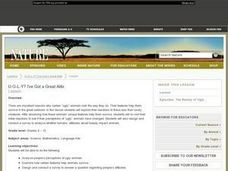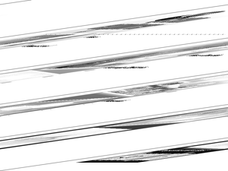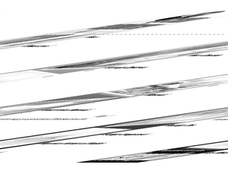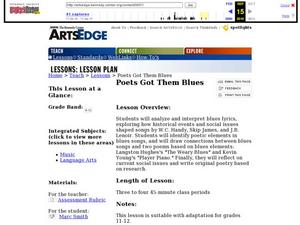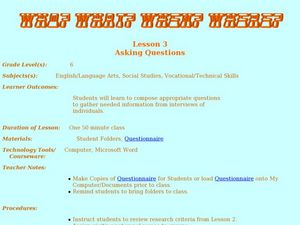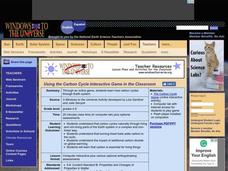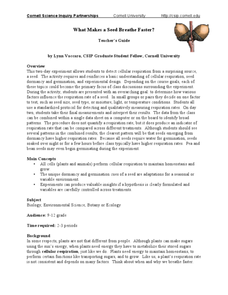Curated OER
How Quickly Disease Spreads
Students demonstrate how quickly disease spreads and the importance of protective measures with communicable diseases. They examine past epidemics such as the Bubonic Plague and make predictions about future epidemics.They compare and...
Curated OER
Fraction Conversion 2 (With Percents)
Fifth graders determine how to convert fractions, decimals, and percents. In this conversion lesson, 5th graders use an on-line applet to practice making these conversions. They review how to make the conversions in a whole class lesson...
Curated OER
U-G-L-Y? I've Got a Great Alibi
Students create a survey to explore people's perception of beauty. For this biology lesson, students explain how an animal's appearance helps it survive. They analyze survey results and present findings in class.
Curated OER
Time is In
Analyze the influence of culture, media, technology, and other factors on health. High schoolers will identify and recognize propaganda techniques (glittering generalities, bandwagon, sex appeal, testimonial, transfer, etc.) and write a...
Curated OER
From Smithson to Smithsonian: The Birth of an Institution
Students identify and evaluate primary and secondary sources relating to James Smithson and his gift to the United States. In this Smithson to Smithsonian lesson, students also examine the debate surrounding how to use the gift from...
Curated OER
Reduced Fare
Learners discover the relationship between tectonic plate boundaries and the communities of life that thrive at such boundaries. In this biology lesson, students find that methane from oxidized carbon in sediments provides nutrients for...
Curated OER
The Tell-Tale Plume
High schoolers examine hydrothermal vents. In this ocean lesson, students identify changes in physical and chemical properties of sea water caused by hydrothermal vents.
Curated OER
Save Your Breath
Students discuss metabolism. In this metabolism lesson, students evaluate evidence form a research report and discuss the basis for hypothetical metabolic adaptations to low-oxygen environments in the anchialine caves.
Curated OER
Technology: Recipes Around the World
Students research international cuisine and create Web pages based on them. Once they have organized their findings, they demonstrate their research with a multimedia presentation. The project concludes with a party using food ...
Curated OER
They're Everywhere! They're Everywhere!
Learners gain an appreciation of the polygons and polyhedrons around them that make their world one of order and strength. They build polygons and polyhedrons, and then construct airplanes out of polygons.
Curated OER
School Lighting Audit
Students identify the data included in an energy audit. They perform an audit on the lighting in their school building. They complete a worksheet and discuss lighting issues with school staff.
Curated OER
Detectives
Learners research the respiratory system and the diseases that affect it.
They construct a model of a pair of working lungs and develop an experiment that will decrease lung inflation.in addition, they create a portfolio of their findings.
Curated OER
Tiananmen Square
Young scholars identify and explain the Tiananmen Square incident of June 1989.
Studentsl compare what it is to be an American Citizen (Democracy) vs.
Chinese Citizen (Communism). Young scholars identify and define various vocabulary...
Curated OER
Rabies-The Global Connection!
Students explore common misconceptions about rabies. In this health science instructional activity, students discuss how this disease can be treated and prevented. They research and create an information pamphlet about rabies.
Curated OER
Bermuda: Search for Deep Water Caves: Living Fossils
High schoolers explore relict species. In this anchialine cave lesson, students identify relict species associated with anchialine caves, and explain the importance of preserving anchialine caves and species.
Curated OER
Poets Got Them Blues
Contemplate what music learners listen to and why they listen. Can they find poetry within music lyrics? Specifically hone in on blues lyrics and ruminate upon the social issues prevalent in the themes. Particular song lyrics coincide...
Curated OER
Digging Up Dino Data
Third graders use the Internet to research a specific dinosaur. They work in pairs and individually to browse dinosaur websites, take notes on pertinent information, write, edit and illustrate reports. They post their work.
Curated OER
Is Bigger Always Better?
Explore rational numbers with the young mathematicians in your class. They will investigate decimals, fractions, and percents before ordering and comparing rational numbers. This multi-day unit includes differentiation activities and...
Curated OER
Who? What? When? Where? Asking Questions
Sixth graders interview Veterans or role play to answer who, what, where, when questions. In this Veteran's Day questioning activity, 6th graders learn about the events in the military service of veterans. Students may simulate...
Curated OER
Yellow Pages Ad-dition
Students determine the revenue generated by sample pages from the Yellow Pages. They discuss the value of advertising a business in this venue. They use the local telephone directory and some fictitious ad rates to lead their inquiry.
Curated OER
Using the Carbon Cycle Interactive Game in the Classroom
An online reading and interactive game bring the path of a carbon molecule to life for your earth science explorers! As an assessment, learners can map out or write about their experience in the carbon cycle. Thoroughly written...
Curated OER
What Makes a Seed Breathe Faster?
Here's a five-star lesson plan in which inquisitors conduct sophisticated experimentation with cellular respiration in plant seeds. Placing seeds in a closed system they measure the amount carbon dioxide produced and relate it to...
Curated OER
Changing Planet: Permafrost Gas Leak
Pair earth scientists up to use an amazing online arctic portal mapping tool and Google Earth to analyze permafrost changes. They compare changes to data on atmospheric concentrations of methane to see if there is a correlation. Then...
Propaganda Lesson
This lesson can be used as a standalone lesson or as an introductory lesson. There is also a PowerPoint Presentation that includes videos and an internet-based interactive activity provided by Holt, the textbook publisher. Click the...


